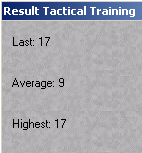I'm still working through the problems I got wrong in the first Circle. Because of the delay with the tournament and such, I will probably repeat Circle 1 before going on to Circle 2. I have also started using Fritz 9's excellent 'Attacking Training' option, where you have to click on all the pieces under direct attack (for both sides) in a given amount of time. This is a great feature for this patzer: I still have a problem missing my opponent's pieces that I should be grabbing (under time trouble, I left a rook
en prise in the tournament last weekend, for instance). This is a humbling exercise, as I sometimes take up to a
full minute to see and click all the attacked pieces on a board! It is clearly a pattern-recognition skill that I need to work on, and I would probably include it in the Chess Vision Drills after the Concentric Squares if I were starting over.
As for opening stuff, in the tournament this weekend, I was unprepared against a basic variation of the queen's gambit accepted as black. After 1 d4 d5 2 c4 dxc4 he played e4. An obvious move that I should be prepared for. I wasn't. This got me into serious trouble by move 10.
There are two points about studying openings that the tournament helped me learn.
1. I have been studying openings wrong. I was studying them slowly, methodically, up to
fourteen moves deep, making sure to understand the ins and outs of each reasonable-looking response by my opponent. As everyone
knows, this is a mistake. I figured, I'll just play based on principles as I slowly build up a badass, GM-level, opening repertoire. There are two problems with this. First, as everyone knows, things rarely follow book out past four to six moves, especially at my level. Second, while I may know certain lines really well, there are other lines that are likely to occur in real games that I have completely neglected. It is time to sacrifice depth for breadth.
2. Because of my desire to go for depth rather than breadth, it is very tempting to study an opening 'system' which consists of basically the same move order no matter what the opponent plays. Unfortunately, such systems (e.g., 1...b6 for black, or the English for white) are typically in the hypermodern style and involve giving up space in the center. I hate the resulting middlegames. Oh well.
Hence, I have decided to change my study of openings to conform to what all the best instructors say. No matter how tempted I am to do otherwise, I am not allowed to study any line more than
four moves in (eight ply). No matter how obvious and dangerous my opponent's response looks, I am not going to let myself explore it until I encounter it in a real game. Once I have my four-move opening book for all the major possibilities, then I am
not allowed to expand the book, only study it, until things go off book in a
real, as opposed to
imaginary, game. Once I see something in a real game that is not in my book, I can then extend that line for four more moves (no more). This more practical opening book will be most likely to help me in real games.
So, here is my plan. As white, develop response (after 1. e4), to:
a. e5
b. Sicilian
c. French
d. Scandinavian
e. Pirc/Modern
As black, develop responses to:
a. e4 (I've already got a lot on this)
b. d4
c. c4
I've got the books. I just need to use them. My goal is to finish the book before my first game in the next 45/45 tournament game I play in (which will be sometime after June 20).
The
Rule of Ten is still in effect. That is, I am still focusing in on tactics more than anything else.
